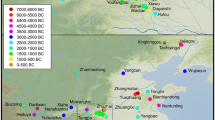Abstract
Cereal grains play a pivotal role in the rise and character of the Indus civilization. Archaeologists have traditionally focused their attention on the large-grained crops of wheat and barley while often minimizing the importance of the smaller-grained millets. Both environmental and cultural variables influence crop selection in the past as well as today. This paper explores the role and significance of cereal grain size during the evolution of the Indus civilization.



Similar content being viewed by others
References
Benard RB, Toft CA (2007) Effect of seed size on seedling performance in a long-lived desert perennial shrub (Ericameria Nauseosa: Asteraceae). Int J Plant Sci 168 No 7:1027–1033
Bewley JD, Black M, Halmer P (2006) The encyclopedia of seeds: science, technology and use. CABI, Wallingford
Black JN (1956) The influence of seed size on depth of sowing on pre-emergence in Subterraneum L. Aust J Agric Res 7:98–109
Blumler MA (1992) Seed weight and environment in mediterranean-type grasslands in California and Israel. Ph.D. Dissertation, University of California, Berkeley
Blumler MA (1993) Successional pattern and landscape sensitivity in the Mediterranean and Near East. In: Thomas DSG, Alison RJ (eds) Landscape sensitivity. Wiley, Chichester, pp 287–305
Blumler MA (1998) Evolution of caryopsis gigantism and agricultural origins. Research in contemporary and applied geogrphy: a discussion series 22:1–46. Department of Geography, Binghampton University, Binghampton
Dhavalikar MK (1995) Cultural imperalism: Indus civilization in Western India. Books & Books, New Delhi
Diamond J (1997) Guns, germs and steel: the fates of human societies. W.W. Norton & Co, New York
Fuller DQ (2001a) Fuller, harappan seeds and agriculture: some considerations. Antiquity 75:410–413
Fuller DQ (2001b) Fifty years of archaeobotanical studies in India: laying a solid foundation. In: Settar S, Korisettar R (eds) Indian archaeology in retrospect: proto history archeology of the Harappan civilization, vol II. ICHR, New Delhi, pp 247–364
Fuller DQ (2007) Contrasting patterns in domestication and domestication rates: recent archaeobotanical insights from the old world. Ann Bot 100:903–924
Fuller DQ, Madella M (2001) Issues in Harappan archaeobotany: retrospect and prospect. In: Settar S, Korisettar R (eds) Indian archaeology in retrospect: proto history archeology of the Harappan civilization, vol III. New Delhi, ICHR, pp 317–390
Government of India (1976) Wealth of India: raw materials, vol X. Council of Scientif and Industrial Research, New Delhi
Glover C, Ray HP (1994) Civilizations in South Asia. In: Cunliffe B (ed) Old world civilizations: the rise of cities and states, vol 3. American Museum of Natural History, Harper Collins, pp 61–76
Hendrix SD, Trapp EJ (1992) Population demography of pastinaca sativa (Apiaceae): effects of seed mass on emergence, survival, and recruitment. Am J Bot 79:365–375
Hulse JH, Laing EM, Pearson DE (1980) Sorghum and millets: their composition and nutritive value. Academic, New York
Kajale M (1991) Current status of Indian paleoethnobotany: introduced and indigenous food plants with a discussion of the historical and evolutionary developments of Indian agriculture and agricultural systems in general. In: Renfrew J (ed) New lights on early farming—recent developments paleoethnobotany. Edinburgh University Press, Edinburgh, pp 155–189
Kenoyer J (1998) Ancient cities of the Indus valley civilization. American Institute of Pakistani Studies, Oxford
Meadow R (1996) The origin and spread of agriculture in Northwestern and South Asia. In: Harris D (ed) Origin and spread of agriculture and pastoralism in Eurasia. UCL Press, London, pp 390–412
Nakamoto T, Matsuzaki A, Shimoda K (1992) Root spatial distribution of field-grown maize and millets. Jpn J Crop Sci 61:304–309
Possehl GL (1999) Indus age the beginnings. University of Pennsylvania Press, Philadelphia
Possehl GL (2003) The Indus civilization: a contemporary perspective. Altamira Press, New York
Possehl GL, Raval MH (1989) Harappan Civilization and Rojdi. Oxford & IBH Publishing, New Delhi
Seetharam A, Riley KW, Harinarayana G (1990) Small millets in global agriculture, proceedings, international small millets workshop, Bangalore (India). International Development Research Centre, New Delhi
Sletvold N (2002) Effects of plant size on reproductive output and offspring perormances in the facultative biennial digitalis purpurea. J Ecol 90:958–966
Stearns SC (1992) The evolution of life histories. Oxford University Press, Oxford
Weaver JE (1926) Root development of field crops. McGraw Hills, New York
Weber SA (1999) Seeds of urbanism: paleoethnobotany and the Indus civilization. Antiquity 73:813–826
Weber SA (2001) Seeds of urbanism revisited. Antiquity 75:413–414
Weber SA (2003) Archaeobotany at Harappa: indications for change. In: Weber SA, Belcher WR (eds) Indus ethnobiology: new perspectives from the field. Lexington Books, Lanham, pp 175–198
Weber SA, Fuller DQ (2007) Millets and their role in early agriculture. Pragdhara 16:1–18
Weiss E, Wilma W, Dani N, Ofer BY (2004) The broad spectrum revisited: evidence from plant remains. PNAS 101 No. 26:9551-9555
Winn AA (1985) Effects of seed size and microsite on seedling emergence of prunella vulgaris in four habitats. J Ecol 73:831–840
Author information
Authors and Affiliations
Corresponding author
Rights and permissions
About this article
Cite this article
Weber, S., Kashyap, A. & Harriman, D. Does size matter: the role and significance of cereal grains in the Indus civilization. Archaeol Anthropol Sci 2, 35–43 (2010). https://doi.org/10.1007/s12520-010-0025-0
Received:
Accepted:
Published:
Issue Date:
DOI: https://doi.org/10.1007/s12520-010-0025-0




